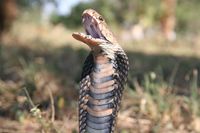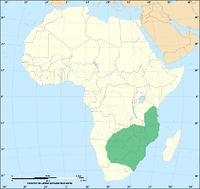Mozambique spitting cobra
| Mozambique spitting cobra | ||||||||||||||||||||
|---|---|---|---|---|---|---|---|---|---|---|---|---|---|---|---|---|---|---|---|---|
 Mozambique spitting cobra
| ||||||||||||||||||||
| Scientific classification | ||||||||||||||||||||
| ||||||||||||||||||||
| Binomial name | ||||||||||||||||||||
| Naja mossambica Peters, 1854[1][2][3] | ||||||||||||||||||||
 Distribution of the Mozambique spitting cobra
| ||||||||||||||||||||
| Synonyms | ||||||||||||||||||||
|
The Mozambique spitting cobra (Naja mossambica), also referred to as M'fezi is a species of spitting cobra found in southeastern Africa. A relatively small sized snake, it is venomous and capable of ejecting venom at a potential predator or threat more than 2 m (6.56 ft) away. This species is very common throughout its range and is responsible for many snakebites.
Etymology
The Mozambique spitting cobra was first described in 1854 by Wilhelm Peters, a German naturalist.[4] The generic name naja is a Latinisation of the Sanskrit word nāgá (नाग) meaning "cobra". The specific epithet mossambica is Latin and simply means "Mozambique".
Description
This is a small to medium, slightly depressed, tapered and moderately slender bodied snake with a medium length tail. The body is compressed dorsoventrally and subcylindrical posteriorly. Like other cobra species, it has long cervical ribs capable of expansion to form a hood when threatened. The Mozambique spitting cobra averages between 0.9 m (2.95 ft) and 1.1 m (3.61 ft) in length, but may grow up to 1.5 m (4.92 ft) in length. The tail on this species is quite long and accounts for 15-20% of the total length of the snake. The longest measured specimen on record was 1.54 m (5.05 ft) long and was found in Kwa-Zulu Natal, South Africa.[5] The head is broad, flattened, blunt and slightly distinct from the neck. The canthus is distinct. The snout is rounded and the eyes are medium in size with round pupils. The dorsal scales are smooth and strongly oblique. The colour on the back is usually brownish, pinkish or olive greenish in juveniles. As the snake matures, the colours begin to fade and become darker. Adults will turn out to be more slate grey to olive brown with dark edged scales. The ventral side is mostly peach to pinkish or grey, sometimes yellowish with black crossbars. In the neck and throat are black bars across, sometimes speckles, blotches and spots mixed are mixed. Some specimens only have a few black spots while others can be almost black.[6][7]
Scalation
Dorsal scales are in 23-25 (rarely 21 or 27) rows at midbody, with 177-205 ventrals and 52-71 paired subcaudals. The anal shield is entire. There are 6 (rarely 7) upper labials with the 3rd (sometimes 3rd and 4th) entering the eye, and 9 (sometimes 8, 10, or 11) lower labials, as well as 2 preoculars (sometimes 1) and 3 (sometimes 2) postoculars. Temporals are variable.[6]
Distribution and habitat
Geographical distribution
This species is found in parts of east and southern Africa. It occurs across the entire northeast of South Africa in the provinces of Kwa-Zulu Natal, Mpumalanga, Limpopo to Gauteng and parts of Free State to the eastern part of the province of North West. Also found throughout Swaziland, Zimbabwe and Mozambique to much of northeastern Botswana, Zambia, Malawi, northeastern Namibia, southeastern Angola and southern Tanzania including Pemba island.[7][8]
Habitat
The Mozambique spitting cobra is the most common cobra found in its range. This species is quite adaptable and can be found in a wide variety of habitats and biomes. They can be found in ticket and moist lowland savanna bushveld, in coastal forests, bush and thorn fields, sometimes in semi desert regions, and broken rocky country. This snake favours retreats in hollow logs, abandoned termite mounds and rodent holes, preferably close to a permanent water source. It is also commonly found foraging near or often in human settlements, usually at night.[6]
Behaviour and ecology
This species is terrestrial and nocturnal, although juveniles often forage during the day. Adults may be seen basking near a retreat or foraging on overcast days. The Mozambique spitting cobra is particularly fond of water. This is a timid snake species that rarely stands its ground and quickly seeks an escape if disturbed in anyway. If cornered it may spread its hood, but it will not hold the pose for too long. The species' main defense is to "spit" or eject its venom at the eyes of a potential predator or threat. Its fangs are specially modified for spitting venom. The venom canal openings at the tips are directed forwards and at the right angles to the fangs, enabling the snake to eject its venom to a distance greater than 2 m (6.56 ft). This species does not always spread a hood before spitting and may only open its mouth slightly before doing so. It can spit effectively from a concealed position within its retreat. It rarely bites and often feigns death.[6][7]
This cobras diet consists mostly of amphibians, other snakes (especially puff adders), birds, eggs, small mammals, and even insects occasionally.[5][6]
This species' main predators are other snakes.[6]
Reproduction
This is an oviparous species that lays 10-22 eggs in midsummer. Hatchlings measure 23 cm (9.06 in) to 25 cm (9.84 in) in length and are completely independent from birth.[6]
Venom
The Mozambique spitting cobras venom is made up primarily of cytotoxins, but also retains the neurotoxins like most other elapids. However, the cytotoxins cause severe local tissue damage that often requires skin grafts. Other symptoms of a bite may include drowsiness and reduced breathing. It is responsible for a considerable amount of snakebite incidents throughout its range, but deaths are rare. Envenomations can be treated successfully with SAIMR polyvalent antivenom.[6]
Cited references
- ↑ Naja mossambica (TSN 700631) at Integrated Taxonomic Information System. Accessed 26 May 2012.
- ↑ Naja mossambica PETERS, 1854 at The Reptile Database. Accessed 26 May 2012.
- ↑ Species Naja mossambica at the Species2000 Database
- ↑ Peters,W.C.H. 1854. Diagnosen neuer Batrachier, welche zusammen mit der früher (24. Juli und 17. August) gegebenen Übersicht der Schlangen und Eidechsen mitgetheilt werden. Ber. Bekanntmach. Geeignet. Verhandl. Königl.-Preuss. Akad. Wiss. Berlin 1854: 614-628
- ↑ 5.0 5.1 Branch, Bill (1998). Field Guide to the Snakes and Other Reptiles of Southern Africa. Ralph Curtis Publishing. p. 109. ISBN 0883590425.
- ↑ 6.0 6.1 6.2 6.3 6.4 6.5 6.6 6.7 Marais, Johan. (2004). A Complete Guide to the Snakes of Southern Africa. Cape Town, South Africa: Struik Nature. 108-109 pp. ISBN 1-86872-932-X.
- ↑ 7.0 7.1 7.2 Mozambique Spitting Cobra: General Details at Clinical Toxinology. Accessed 26 May 2012.
- ↑ Spawls, Stephen. Branch, Bill. (1995). The Dangerous Snakes of Africa: Natural History, Species Directory, Venoms and Snakebite. Oriental Press, Ralph Curtis Books. ISBN 0-88359-029-8.